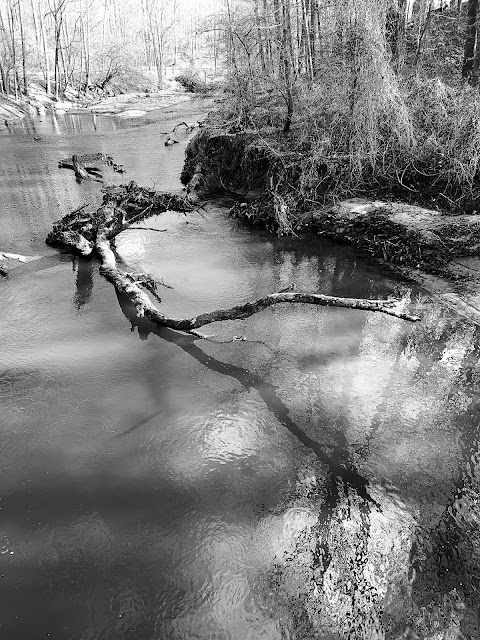Picture that you are in the National Gallery of Art , sitting with me on a large, comfy leather couch enjoying walls of lovely impressionist paintings. A small group of visitors come in to the gallery and with machine-like efficiency make cell phone images of every painting on the walls, and then move on to the next gallery. Look closely and you'll see a guard sigh. The visitors have documented but never really seen any of the paintings. Such a waste of Monet. So many look, so few really see. That's always been the primary use of photography. My story today is about how I could move past documenting. Maybe it will inspire you.
Actually it is two trees. The one on the right began it's life growing on a fallen dead tree. After years, the dead tree disappeared leaving three legs arching to the ground. On left, a younger tree grew up between two legs. Maybe it's a three-legged tree with a "friend". Anyway, it is interesting and worth really moving from looking to seeing. I did that by sketching it and adding watercolors. I devoted about 2-1/2 hours going from a tree to a combination of particular parts that add up these two trees. Once complete, this was not just a tree, but now it is an individual.
There's a difference. This experience is at the heart of what can move photography from look to see. My time in the recent months has been a balance of sketching and photographing with the aim to shift images to seeing. (No more sketches now, just photos representing deeper seeing. I find it easier to draw when no one gets to see my mistakes. Also, working in ink taught me to ignore errors and just keep moving forward.)
Here is a scene from along Rock Creek in Washington, DC.
The beech trees are tenacious. They take hold on top of the rocks and send roots around all stony barriers. Removing all color often removes distractions to really seeing. (Consider this a portrait and maybe it will influence family snapshots you make?)Still along Rock Creek on an explore one morning, there is this fallen tree washed into the creek. The reflection of the tree in the foreground caught my attention. Typically, my eye begins exploring at the strongest contrast, which in this case it was the tip of the dead tree at the reflection.
What follows is a simple image that I first sketched with much attention to the textures of the huge oak tree in the fore.
The tree textures in the middle ground also were sketched in detail. This is also in Rock Creek Park.
There are also times where color deserves attention. On a post-Christmas wander in Leo's woods, I spotted a sulfur colored fungus on a decaying beech stump. It's a good example of moving from look to see. First, I needed the distance to be de-focused. Next, the subtle greens and rusty leaves seemed so much of the story that monochrome was out of the question.
I made over 40 images of this before I was happy with the background. The stump needed to be separated from the hemlock to the left and beyond that, the rest needed to be blurry. That's the way I will sketch this for a watercolor.
The above was of such deep involvement that I lost all sense of time. That's a real benefit of learning to really look deeply. It's a type of Zen (seeing) that I first discovered in the National Gallery. I am doing more sketching now than photographing, yet when the camera is involved the influence of drawing with pen on paper is strong.
As I write this, the long range weather forecast uses the word snow. I'm excited to have the simplicity of snowy ground, but it is unlikely I will find it possible to hold a pen and draw with cold fingers. My seeing will only move to drawing once inside.
My hope is that there is a mix of entertaining images plus useful ideas.
Best wishes for 2024.
Paul Schmitt





